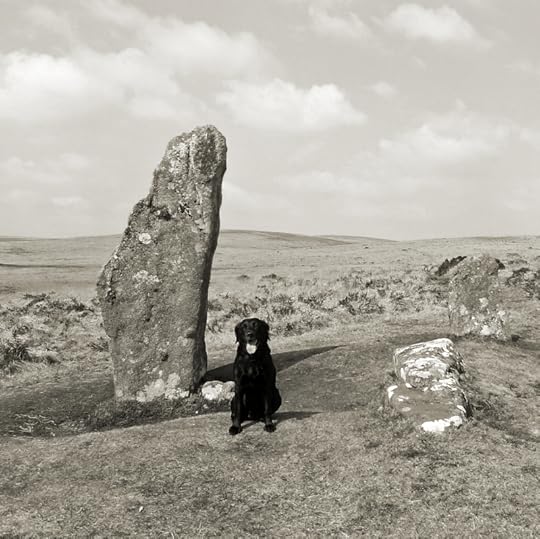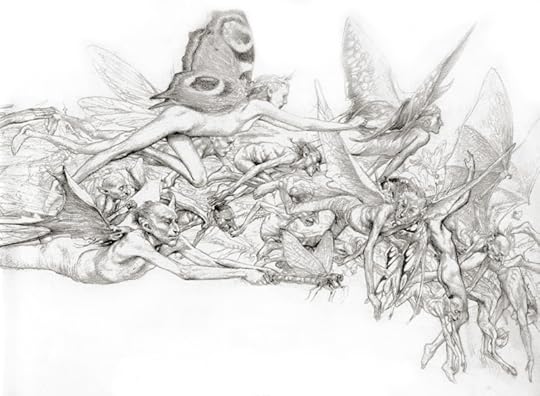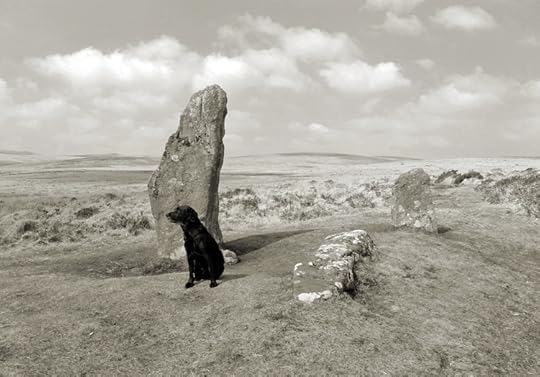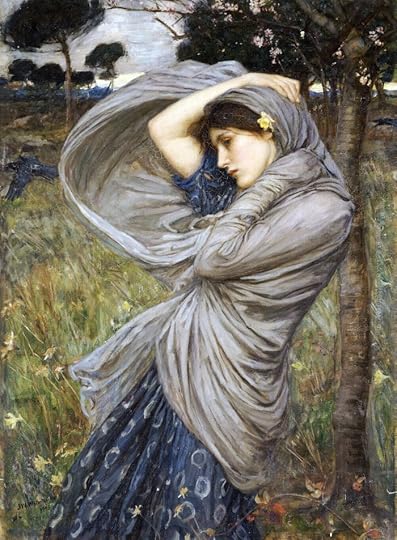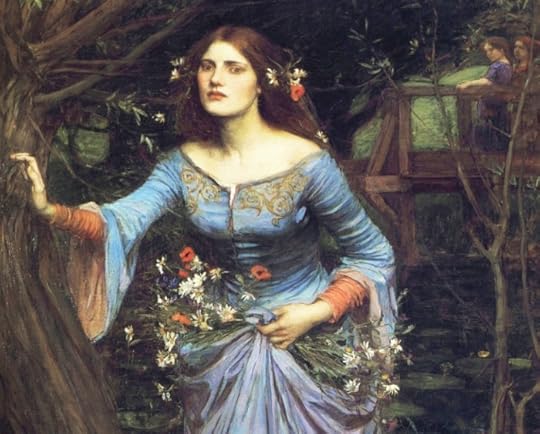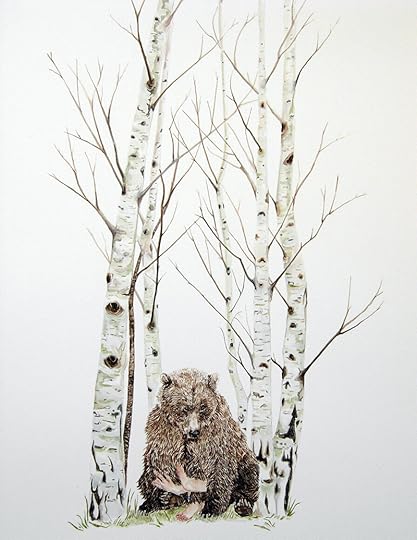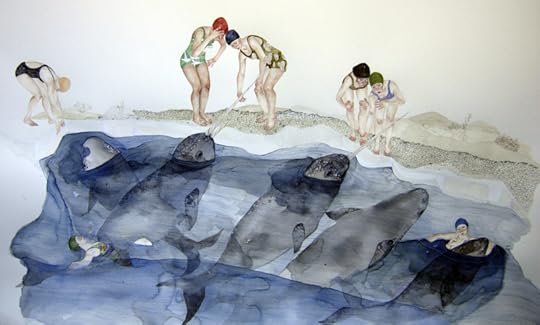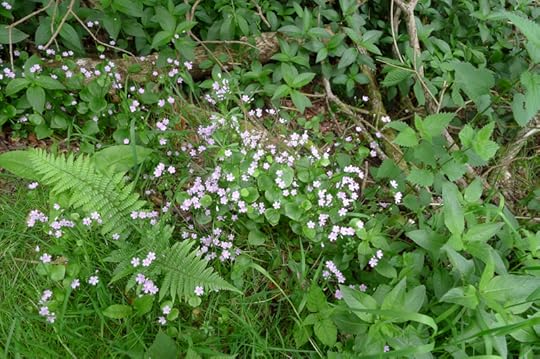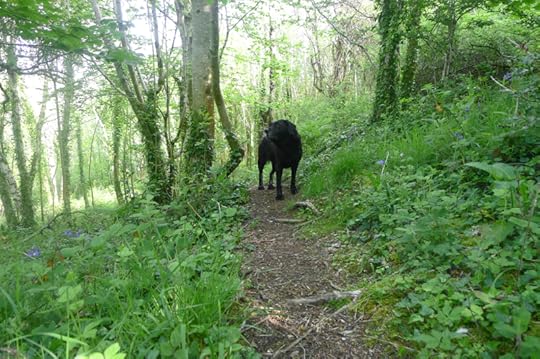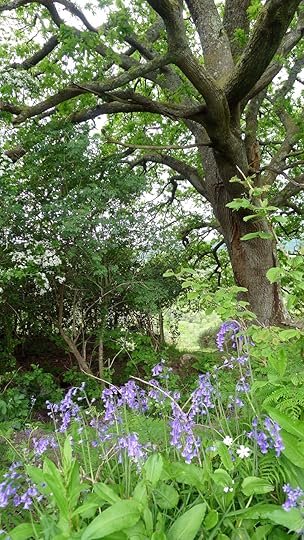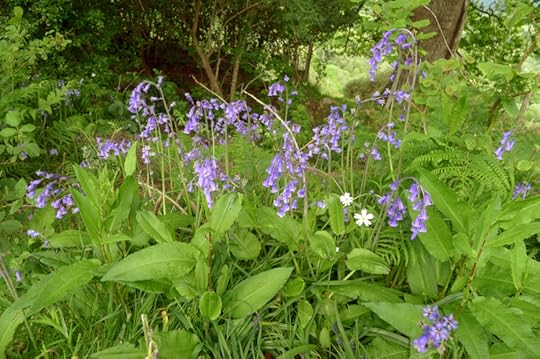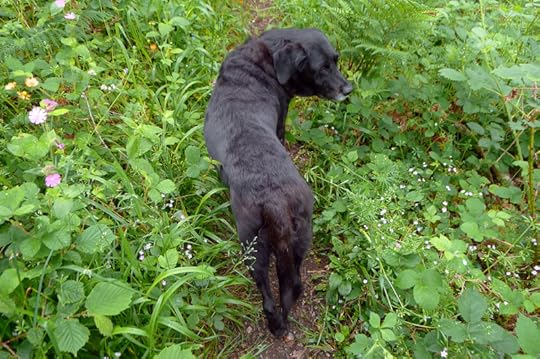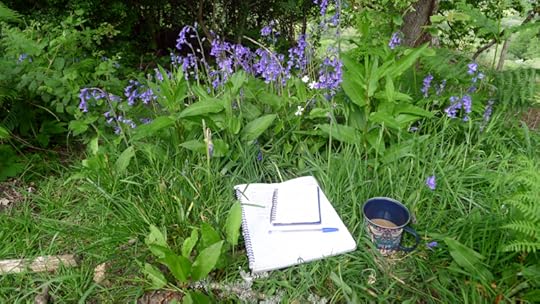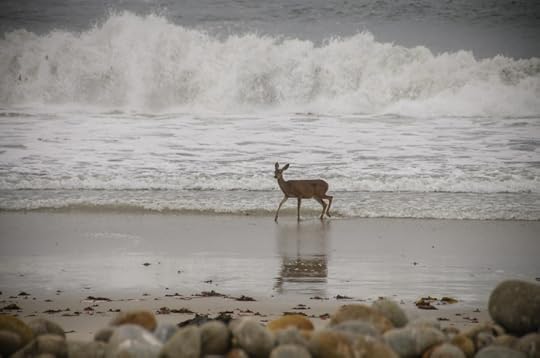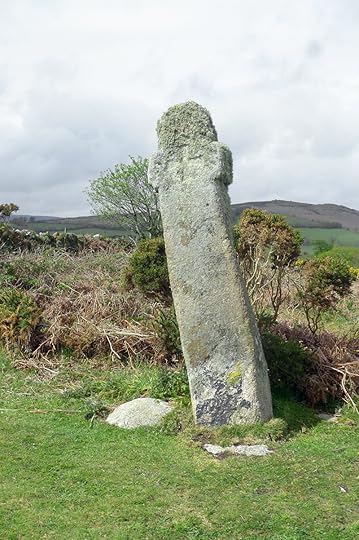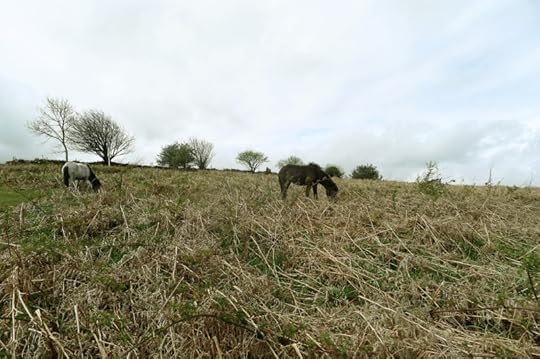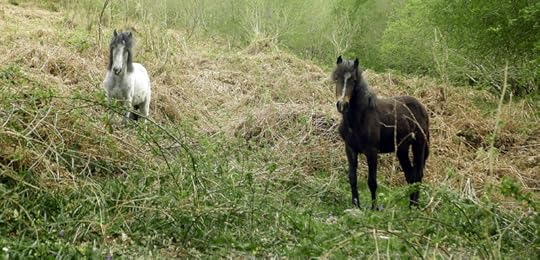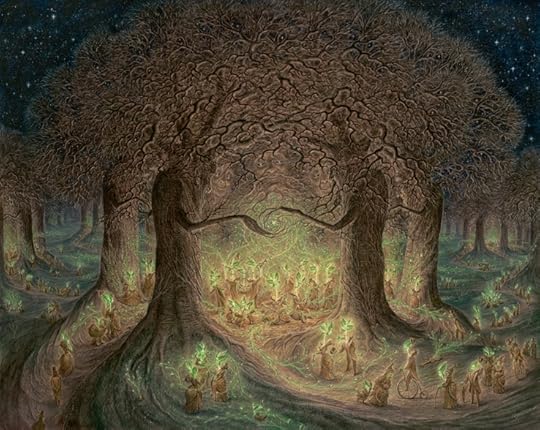Terri Windling's Blog, page 13
June 21, 2021
On Summer Solstice
Tilly and I wish you all the good blessings of midsummer, when the borders between the worlds are thin and the stones of Dartmoor rise up and dance. Be sure to carry salt and oak leaves in your pocket, garland yourself with wildflowers, and drive your cattle through the smoke of a midnight bonfire for protection from fairy mischief!
My apologies for the lack of posts last week; I'm afraid I've been down with health problems again. I'm back in the studio today, catching up on the work I've missed, and hope to be posting regularly from tomorrow onward.
Let's raise a toast to good health for all: for strength and grace of body, mind, and spirit. Wishes and spells have particular potency at this magical time of year.
Pictures: Tilly at Scorhill stone circle on Dartmoor, and a swarm of fairies by Alan Lee.
June 13, 2021
Tunes for a Monday Morning
I'm in the mood for old songs and balladry today, and I hope you are too. But beware, there's dark water ahead. Ballads rarely end happily ever after....
First, two songs from the Anglo-Irish quartet The Haar (Cormac Byrne, Molly Donnery, Murray Grainger, and Adam Summerhayes), whose debut album was released last year. The videos here were recorded this spring, during the latest Covid lockdown.
Above: "Black is the Colour," a traditional song with variants found in the Irish, Scottish, and Appalachian folk traditions.
Below: "Annachie Gordon," Child Ballad #239. (For more information about Francis Child and his influential collection of English & Scottish ballads, go here.)
Above: "The Cruel Brother," Child Ballad #11, performed by the Anglo-Scots folk trio Lau (Kris Drever, Martin Green, and Aidan O'Rourke). This murderous tale appears on their new album Folk Songs (2021).
Can we get any darker? Yes, we can. Below: "Young Johnstone," Child Ballad #88, performed by the great English folksinger June Tabor. The song is from her sixteenth solo album, An Echo of Hooves (2016).
Above: "The Gardener," Child Ballad #219, performed by the English folk trio Lady Maisery (Hazel Askew, Hazel James, and Rowan Rheingans), from their first album, Weave & Spin (2011). "This is a very mysterious dialogue between a gardener and a woman who does not appreciate his flowery propositions," they say. "It's a Child Ballad which Hannah has adapted from a few different versions."
Below: "King Henry," Child Ballad #32, a "loathly lady" song performed by Alasdair Roberts, Emily Portman, and Lucy Farrell (of The Furrow Collective). It was was recorded for The Mark Radcliffe Folk Sessions (BBC Radio 2) in 2014.
Above: "The Slighted Lover" performed by Jarlath Henderson, from Northern Ireland, with Duncan Lyall, Hamish Napier, and Innes Watson. The song is a broadside ballad with a complicated history, going back at least to the 17th century. There's no murder here, but that's not to say love goes smoothly in this ballad either. Hendersen's rendition appeared on Hearts Broken, Heads Turned (2016).
Moving from ruin to madness, below: "Bedlam Boys," a 17th century song performed by the Anglo-Welsh folk trio The Trials of Cato (Tomos Williams, Robin Jones, and Polly Bolton). It's from their new album, Gog Magog, due out later this year.
Art above: "Boreas" and "Ophelia" by John William Waterhouse (1849-1917).
June 11, 2021
Come into animal presence
Ever since humans have lived upon earth, writes Lyanda Lynn Haupt,
"we have made our homes and conducted our movements in proximity to other animals. The more prominent our enclosed modern dwellings, encapsulated modes of transportation, indoor workplaces, and every-present technology become in everyday life, the more we are separated from the presence of other animals who have always been a part of human life-making. The beloved domestic dogs and cats who share our homes are a delight, but no substitution for time alert to the vivid intricacy of wild visitations and interactions.
"We are experiencing now an isolation named species loneliness by Michael Vincent McGinnis in a 1993 paper for Environmental Ethics. In his book Our Wild Calling, Richard Louv describes this modern human condition as 'a desperate hunger for connection with other life....All of us are meant to live in a larger community, an extended family of other species.' Without this, a number of pathologies grow within us and 'the family of humans loses comfort, companionship, and perhaps even the sense of higher power, however one defines it.' Animals, too, have evolved with humans among them -- and this distant relationship in which we currently live may be an incalculable, unknowable loss to them as well."
Communication between animals and humans, notes Jay Griffiths,
"is a fixture of science and has led to curious discoveries: dolphins communicating with humans will modulate the pitch of their calls to stay within the realm of human hearing; orangutans will modify their gestural signals according to the comprehension of their human audience.
"Such unfeigned communication, unbuyable and uncommandable, delights us as if they the unfallen were in that moment inviting us to step across, right through the curtain into the Dreaming. 'Everything has and tells a story. Everything communicates, through its own language and its own Law,' say Indigenous Australian Yolngu people from Bakawa in north-east Armhem Land. Indigenous cultures have kept faith with the animals as part of what it means to belong, and the world is larger and more vivid when animals and birds and insects are imbued with spirit and significance, when there is Mind of unknowable diversity, elastic and ecstatic, until the very air is electric with Message and there are more stories than stars.
"The communication between animals and humans is sometimes a terrible reproach. While elephants in captivity can speak human words, wild elephants have a word for 'human being' and, points out animal philosopher Eva Meijir, in Animal Languages, it indicates 'danger.' I have always wanted to hear a koala call. I have never wanted to hear one cry for help, its fur singed, its paws and nose burned, crying little bleats of bewilderment, and whimpering with pain in the arms of the Australian woman who rescued it from one of the bushfires caused by the climate crisis. Something in me died that day, and I am not alone. We need their well-being, their voice, their happiness, their life.
"When other creatures speak to us, a breach feels healed into wholeness, wellness. Worldwide, shamanic lore has included the art of shapeshifting; these animal transformations are often treated as fact without much analysis but the revelation to me is that healing, whether individual or social, is thought to come about through animal mind. Animals are the Healers, if we would but let them. This is physically true, as we know that, for example, heart surgery patients recover more quickly if they have a cat on their bed. Dogs can detect certain cancers through their heightened sense of smell and some dogs are now being trained to detect Covid-19. Emotionally, animals are the first-responders for the human heart, and eschewing the natural world is life-denying, refusing its most potent medicine: vitality.
"Vitality is at the heart of healing traditions: acupuncture or yoga, the concepts of Chinese Chi or Indian Prana, the life force in flow. It is among the five 'character strengths' most correlated with happiness, according to The Journal of Social and Clinical Psychology, the others being curiosity, optimism, gratitude and the ability to love and be loved. Vitality means living in vividness, alert, the senses picking up everything. It is the embodiment of life, keener and more alive. It is a core strength and not necessarily correlated with age: an eighty-year-old can be elastic with vitality. It is zest, enthusiasm, energy: sheer sap-rising, the very quick of life....Vitality is the aspect of human happiness that is most keenly associated with natural connection, as natural environments improve emotional functioning and attention. To notice, to attend the world, to be alive to its co-vitalizing, amounts to biophilia, the term used by biologist and naturalist Edward O. Wilson to describe that lovely innate quality of life loving life, and the particular kind of energy it offers is that shining momentness that, in the Homeric world, surrounds the gods: energeia. It is intense presence, wildness incarnate. In this sense, wild animals are the gods still walking -- swimming, tumbling, climbing, pouncing -- in the world."
The passages above are from Lyanda Lynn Haupt's new book Roots: Life at the Crossroads of Science, Nature, and Spirit, and Jay Griffiths new book, Why Rebel. Both are highly recommended. The title of today's post is taken from Denise Levertov's classic poem "Come into animal presence," which you can read here. For animal and human relationships from a folklore point of view, see "The Speech of Animals" and "Married to Magic: Animal Brides and Bridegrooms."
The images today are by Canadian artist Kristin Bjornerud, who was born in Alberta, studied at the Universities of Lethbridge and Saskatchewan, and is now based in Montreal. She's received grants from the Canada Council for the Arts, the Saskatchewan Arts Board, the Ontario Arts Council and the Conseil des arts et des lettres du Qu��bec. Her work has been exhibited nationally and is represented in numerous public collections
"My watercolour and gouache paintings," Bjornerud writes, "explore contemporary political themes, ecological motifs, and personal narratives through the lens of folktales, dreams, and magical realism. In these delicately painted tableaus, a world is revealed wherein dream logic pervades, where women swim with narwhals and vivify hand-knit fauna. These eccentric landscapes are uncanny projections of a possible world where familiar activities are imbued with a mythic quality while, at the same time, extraordinary deeds are carried out with unruffled poise by proud, unconventional heroines.
"My aim is to create contemporary fairy tales that act as a medium through which we may consider our ethical obligations to the natural world and to each other. Retelling and reshaping stories helps us to understand how we are entangled, where we meet, and how our differences may be viewed as disguises of our sameness."
Please visit the artist's website to see more of her wonderful work.
The titles of the artworks by Kristen Bjornerud above (top to bottom) are: Encounter With a Bear, Caterwauling, Exile, Conjuration, In Your Skin, Tiger, Breathing Space, Beneath, and When You Were Wild. All rights reserved by the artist. The text quoted above is from Roots by Lynanda Lynn Haupt (Little, Brown Spark, 2021) and Why Rebel by Jay Griffiths (Penguin/Random House, 2021). All rights reserved by the authors.
A few other posts on animal/human relationships: Kissing the lion's nose, Keeping the world alive, The blessing of otters, Liam Henegan's Beasts at Bedtime , The animal helpers of T.H. White, and Wild Neighbours.
June 10, 2021
The language of loss and love
In her splendid little book Why Rebel, Jay Griffiths despairs of the way we commonly tell the story of climate crisis, noting how it distances us from the urgency and enormity of the ecological devastation unfolding around us. She writes:
"The language we use for this is itself deadly. The mass of ocean writing is a heap of broken plastic words: stock, fisheries, industry, off-shore, tonnage, commercial fleets, sea cages, fish farms, subsidies. Through the language it is hard to see the ocean's true nature, whose vitality needs to be rendered as beautiful as iridescence itself. We speak of an 'extinction event' or 'species decline' because of 'intensive agriculture.' These are lifeless phrases. How easily the eye bypasses them. They are words of tarmac and traffic, not the lovely writhy ivy words of the woods.
"I cannot touch or taste terms like 'habitat loss' or 'pollution' because they are unbeloved words which carry within themselves the toxicity of lifelessness. Humans, we are told, need insects for 'the function and services they provide.' Cold language, cold as coins on corpse eyes, cold as the philosophy that put us here. Words of heart are needed.
"There is a new word in the air: defaunation: the loss of absolute animalness. Defaunation includes the loss of individuals and the loss of abundance. Defaunation, argue researchers in Science magazine, should be as familiar and influential as the word 'deforestation.' Another term for the loss of the world's wild fauna is 'biological annihilation.'
"Please tell me you understand the immensity of this. And if you don't, please think, alone and quietly perhaps, of the unfolding ending. Let me speak simply into the simplicity of your heart, then, and let me just ask you what you love, what makes you happy.
"Is it a child? Is it your partner? Do you love your friend or, Little Prince, do you love your rose? Do you love your dog, your cats, your church, your home, your garden? Your books, perhaps, or the poetry you make, or the music? The meaning you have made of your life, maybe, your health, status, honour or all of these? And this love, then, this happiness that you hold so dear, tell me how it will even exist without the tiniest of beings, the insects, against which we have been so pitiless? Without the insects for the food and the flowers and the soil?"
Barry Lopez is another writer who entwined the language of loss with the language of love in his remarkable and influential books, which changed the way that many of us viewed the world and our place within it. In his essay "Love in a Time of Terror," published shortly before he died (in January), he wrote:
"Evidence of the failure to love is everywhere around us. To contemplate what it is to love today brings us up against reefs of darkness and walls of despair. If we are to manage the havoc -- ocean acidification, corporate malfeasance and government corruption, endless war -- we have to reimagine what it means to live lives that matter, or we will only continue to push on with the unwarranted hope that things will work out. We need to step into a deeper conversation about enchantment and agape, and to actively explore a greater capacity to love other humans. The old ideas -- the crushing immorality of maintaining the nation-state, the life-destroying belief that to care for others is to be weak, and that to be generous is to be foolish -- can have no future with us.
"It is more important now to be in love than to be in power. It is more important to bring E. O. Wilson���s biophilia into our daily conversations than it is to remain compliant in a time of extinction, ethnic cleansing, and rising seas. It is more important to live for the possibilities that lie ahead than to die in despair over what has been lost.
"Only an ignoramus can imagine now that pollinating insects, migratory birds, and pelagic fish can depart our company and that we will survive because we know how to make tools. Only the misled can insist that heaven awaits the righteous while they watch the fires on Earth consume the only heaven we have ever known....In this trembling moment, with light armor under several flags rolling across northern Syria, with civilians beaten to death in the streets of Occupied Palestine, with fires roaring across the vineyards of California, and forests being felled to ensure more space for development, with student loans from profiteers breaking the backs of the young, and with Niagaras of water falling into the oceans from every sector of Greenland, in this moment, is it still possible to face the gathering darkness, and say to the physical Earth, and to all its creatures, including ourselves, fiercely and without embarrassment, I love you, and to embrace fearlessly the burning world?"
Griffiths and Lopez, of course, are not the only writers urging us to pay attention to the language we use when speaking of the more-than-human world. In previous posts, Robin Wall Kimmerer explained how the "grammar of animacy" can foster more respectful relationships with plants and animals; Lyanda Lynn Haupt reflected on the language of inter-species communion; David Abram argued that our conception of language itself as a purely human gift is much too limited; John O'Donohue spoke of animals and compassion from a Celtic point of view; N. Scott Momaday reminded us that speech itself is an ancient form of magic ... and there are so many others (fiction writers, poets, mythologists and storytellers included) who are working to re-enchant our words, re-wild our stories, and re-imagine our place in the living world.
Barry Lopez asks: Is there still time, and is this still possible? I have to believe it is. The great work of loving, of rebelling, and of storytelling carries on. It has only just begun.
Words: The passages quoted above are from Why Rebel by Jay Griffiths (Penguin/Random House, 2021) and "Love in a Time of Terror" by Barry Lopez (Literary Hub, August 7, 2020); all rights reserved by the authors. Lopez's last published book was Horizon (Vintage, 2019), which I highly recommend. You can read a post about it here.
Pictures: The fairy tale illustrations today are by H.J. Ford (1860-1941) and Helen Stratton (1867-1961).
June 9, 2021
What's your story?
I'm out of the office again today, attending to some medical matters. It's nothing new, don't worry -- just the same health issues I've dealt with for many years now and the same old story.
"What���s your story?" asks Rebecca Solnit (in The Faraway Nearby). "It���s all in the telling. Stories are compasses and architecture; we navigate by them, we build our sanctuaries and our prisons out of them, and to be without a story is to be lost in the vastness of a world that spreads in all directions like arctic tundra or sea ice....
"We think we tell stories, but stories often tell us, tell us to love or hate, to see or be seen. Often, too often, stories saddle us, ride us, whip us onward, tell us what to do, and we do it without questioning. The task of learning to be free requires learning to hear them, to question them, to pause and hear silence, to name them, and then become a story-teller."
The hound and I will be back in the studio, back in the hills, and back to Myth & Moor tomorrow. Telling stories.
The passage above is from The Faraway Nearby by Rebecca Solnit (Granta, 2013), which I highly recommend. The poem in the picture captions is from Dog Songs by Mary Oliver (Penguin, 2013). All rights reserved by the authors.
June 7, 2021
Recommended Reading: Mary Oliver on the art of rooting
After our discussion on "rooting" last week, I was reminded of "Home" by , published in her wise and lovely collection Long Life: Essays and Other Writings. Here Oliver writes about the homely, undramatic landscapes that we come to know in an intimate way by living in them day after day, year after year, season after season -- a means of rooting that is slow, patient, and deep. I'm thinking now of my own patch of ground: the small woodland behind my studio and the rise of Nattadon Hill beyond, whose modest beauties are illuminated by my steady relationship with them.
I walk these paths nearly every day: I know the trees and the stones in all kinds of weather; I know where the sicklewort grows, and the Cuckoo Pints; I know where the badger setts are, where the owls come to roost. I grieve when storms damage the stalwart old oaks and celebrate when the bluebells return. All this makes the hillside dear to me, but one needn't live in the countryside to value the physical world we live in -- including the good green lungs of our cities, the raffish edgelands between country and town, and those blessed pockets of wilderness that break through in even the tamest of suburbs. We are all affected by the land that we live on (for good or for ill), if not always properly attentive to that soul-deep connection.
In the following passage from Oliver's essay, she speaks of the way her own familiar landscape, on the north-east coast of America, shaped her psyche and creative work:
"A certain lucent correspondence has served me, all my life, in the ongoing search for my deepest thoughts and feelings. It's the relationship of my own mind to landscape, to the physical world -- especially to the part of which, over the years, I have (and not casually) become intimate. It's no great piece of furniture in the universe -- no Niagara, or rainforest, or Sahara. Yet it is beautiful, and ripples in the weathers as lively as any outpouring from the Great Lakes.
"In its minor turns, and tinsels, and daily changes, this landscape seems actually intent on providing pleasures, as indeed it does; in its constancy, its inexorable obedience to laws I cannot begin to imagine much less understand, it is still a richer companion -- steady commentary against my own lesser moods -- my flightiness, my indifferences, my mind and heart absences.
"I mean, by such flightiness, something that feels unsatisfied at the center of my life -- that makes me shaky, fickle, inquisitive, and hungry. I could call it a longing for home and not be far wrong. Or I could call it a longing for whatever supercedes, if cannot pass through, understanding. Other words that come to mind: faith, grace, rest. In my outer appearance and life habits I hardly change -- there's never been a day that friends haven't been able to say, at a distance, 'There's Oliver, still standing around in the weeds. There she is, still scribbling in her notebook.' But at the center I am shaking, I am flashing like tinsel....
"Daily I walk out across my landscape, the same fields, the same woods, and the same pale beaches; I stand by the same blue and festive sea where the invisible winds, on late summer afternoons, are wound into huge, tense coils, and the waves put on their feathers and begin to leap shoreward, to their last screaming and throbbing landfall. Times beyond remembering I have seen such moments: summer falling to fall, to be followed by what will follow: winter again: count on it. Opulant and ornate world, because at its root, and its axis and its ocean bed, it swings through the universe quietly and certainly."
And on that land, she continues,
"I build a platform, and live upon it, and think my thoughts, and aim high. To rise, I must have a field to rise from. To deepen, I must have bedrock from which to descend. The constancy of the physical world, under its green and blue dyes, draws me toward a better, richer self, call it elevation (there is hardly an adequate word), where I might ascend a little -- where a gloss of spirit would mirror itself in worldly action. I don't mean just mild goodness. I mean feistiness too, the fires of human energy stoked; I mean a gladness vivacious enough to disarrange the sorrows of the world into something better....
"It is one of the great perils of our so-called civilized age that we do not acknowledge enough, or cherish enough, this connection between soul and landscape -- between our own best possibilities, and the view from our own windows. We need the world as much as it needs us, and we need it in privacy, intimacy, and surety."
As I walk the paths of the hill and woods, over and over and over again, following after my bouncy black dog, I'm aware that I do need this place, this connection with something both older and larger than I am. My dreams are steeped in its spring wildflowers, its sheep covered hills and long days of rains; my art is shaped by rowan and oak, stitchwort and bluebells, bracken and birdsong. It's not the first or the only landscape I've loved. It will probably not be the last. But every day I walk on the hill...and look...and listen, paying attention. I "stand around in the weeds" and scribble in a notebook. On good days, on bad days, I'm here. On the hill.
Rooted.
Fearing storms, but still standing.
The text quoted above is from Long Life: Essays and Other Writings by Mary Oliver (Da Capo Press, 2004). All rights reserved by the author's estate. The fairy tale illustration is by Helen Stratton (1867-1961).
On home, land, and the view out the window
In her essay "Home," writes about the value of those homely, undramatic landscapes that we come to know in an intimate way by living in them day after day, year after year, season after season. Reading her words, I was reminded of my own patch of ground: the small woodland behind my studio and the rise of Nattadon Hill beyond, whose modest beauties are deepened by my steady relationship with them. I walk their paths nearly every day: I know the trees and the stones in all kinds of weather; I know where the sicklewort grows, and the Jack-in-Pulpits; I know where the badger setts are, where the owls come to roost. I grieve when storms damage the stalwart old oaks and celebrate when the bluebells return. All this makes the hillside dear to me, but one needn't live in the countryside to value the physical world we live in -- including the good green lungs of our cities, the raffish edgelands between country and town, and those blessed pockets of wilderness that break through in even the tamest of suburbs. We are all affected by the land that we live on (for good or for ill), if not always properly attentive to that soul-deep connection.
In the following passage from Oliver's essay, she speaks of the way her own familiar landscape, on the north-east coast of America, shaped her psyche and creative work:
"A certain lucent correspondence has served me, all my life, in the ongoing search for my deepest thoughts and feelings. It's the relationship of my own mind to landscape, to the physical world -- especially to the part of which, over the years, I have (and not casually) become intimate. It's no great piece of furniture in the universe -- no Niagara, or rainforest, or Sahara. Yet it is beautiful, and ripples in the weathers as lively as any outpouring from the Great Lakes.
"In its minor turns, and tinsels, and daily changes, this landscape seems actually intent on providing pleasures, as indeed it does; in its constancy, its inexorable obedience to laws I cannot begin to imagine much less understand, it is still a richer companion -- steady commentary against my own lesser moods -- my flightiness, my indifferences, my mind and heart absences.
"I mean, by such flightiness, something that feels unsatisfied at the center of my life -- that makes me shaky, fickle, inquisitive, and hungry. I could call it a longing for home and not be far wrong. Or I could call it a longing for whatever supercedes, if cannot pass through, understanding. Other words that come to mind: faith, grace, rest. In my outer appearance and life habits I hardly change -- there's never been a day that friends haven't been able to say, at a distance, 'There's Oliver, still standing around in the weeds. There she is, still scribbling in her notebook.' But at the center I am shaking, I am flashing like tinsel....
"Daily I walk out across my landscape, the same fields, the same woods, and the same pale beaches; I stand by the same blue and festive sea where the invisible winds, on late summer afternoons, are wound into huge, tense coils, and the waves put on their feathers and begin to leap shoreward, to their last screaming and throbbing landfall. Times beyond remembering I have seen such moments: summer falling to fall, to be followed by what will follow: winter again: count on it. Opulant and ornate world, because at its root, and its axis and its ocean bed, it swings through the universe quietly and certainly."
And on that land, she continues,
"I build a platform, and live upon it, and think my thoughts, and aim high. To rise, I must have a field to rise from. To deepen, I must have bedrock from which to descend. The constancy of the physical world, under its green and blue dyes, draws me toward a better, richer self, call it elevation (there is hardly an adequate word), where I might ascend a little -- where a gloss of spirit would mirror itself in worldly action. I don't mean just mild goodness. I mean feistiness too, the fires of human energy stoked; I mean a gladness vivacious enough to disarrange the sorrows of the world into something better....
"It is one of the great perils of our so-called civilized age that we do not acknowledge enough, or cherish enough, this connection between soul and landscape -- between our own best possibilities, and the view from our own windows. We need the world as much as it needs us, and we need it in privacy, intimacy, and surety."
As I walk the paths of the hill and woods, over and over and over again, following after my bouncy black dog, I'm aware that I do need this place, this connection with something both older and larger than I am. My dreams are steeped in its spring wildflowers, its sheep covered hills and long days of rains; my art is shaped by rowan and oak, stitchwort and bluebells, bracken and birdsong. It's not the first or the only landscape I've loved. It will probably not be the last. But every day I walk on the hill...and look...and listen, paying attention. I "stand around in the weeds" and scribble in a notebook. On good days, on bad days, I'm here. On the hill.
Rooted.
Fearing storms, but still standing.
The text quoted above is from Long Life: Essays and Other Writings by Mary Oliver (Da Capo Press, 2004). All rights reserved by the author's estate. The fairy tale illustration is by Helen Stratton (1867-1961).
June 6, 2021
Tunes for a Monday Morning
Songs of the morning to start a quiet day at the cusp of summer....
Above: "L�� R����il" by the Irish folk duo Zo�� Conway and John Mc Intyre, with Irish fiddle & bouzouki player ��amon Doorley (of Dan��), and Scottish singer & multi-instrumentalist Julie Fowlis. The song appears on their collaborative album Allt (2021), inspired by old and new Gaelic poetry from Ireland and Scotland. "A great day, great day," they sing, "I'll have a great day. It won't be long till I see you again."
Below: "Lark in the Clear Air" by Scottish singer/songwriter Karine Polwart, based in Edinburgh. It's from her album and stage show A Pocket of Wind Resistance (2017).
Above: "The Lark" by English singer/songwriter Kate Rusby, from Yorkshire, with Nic Jones. The song appeared on two of Rusby's albums: The Girl Who Couldn't Fly (2005) and 20 (2012).
Below: "Lark in the Morning," a traditional song performed by English singer and fiddle player Jackie Oates, from Staffordshire. The song appeared on her second solo album, The Violet Hour (2008).
Above: "Lemady," a traditional song (also known as "Arise and Pick a Posy") performed by the East London folk group Stick in the Wheel and Jack Sharp (of Wolf People). The song appeared on Stick in the Wheel's fourth album, This and the Memory of This (2018).
Below, "Early One Morning," a traditional song performed by English singer/songwriter Jim Moray, based in Bristol. The song appeared on his second album, Sweet England (2003).
Above: "Awake, Awake," a traditional song performed by The Gigspanner Big Band, consisting of the Gigspanner trio (Steeleye Span's Peter Knight, Sacha Trochet, and Peter Flack), plus the Edgelarks duo (Phillip Henry and Hannah Martin), and John Spiers (of Bellowhead). Other good versions of this classic ballad from the British and American folk traditions include "Waking Dreams" from Martin & Eliza Carthy, "Awake, Awake" from Maz O'Connor, and "The Silver Dagger" from Mandolin Orange.
Below: "May Morning Dew," a traditional song performed by Scottish singer Siobhan Miller, filmed in Glasgow last year. The song appears on her most recent album, All Is Not Forgotten (2020).
June 4, 2021
Recommended Reading: The Art of Doing Nothing
How to Do Nothing: Resisting the Attention Economy by Jenny Odell, an artist and writer based in northern California (the center of the American tech industry), is a book I found myself reading slowly, doling it out, because it presented so much food for thought. This is a very good read if you, like me, worry about the ways that life online, as valuable as it is in many respects, can erode our presence in the physical world, and our ability to concentrate. I should state straight out that Odell is not anti-technology, but believes in using it consciously and well. Her book is a useful text for all who are engaged in the deep, slow work of making art in the shallow, fast world that Silicon Valley is busy creating.
Here's a passage from Odell's introduction that will give you a taste of what's inside:
"We know that we live in complex times that demand complex thoughts and conversations -- and those, in turn, demand the very time and space that is nowhere to be found. The convenience of limitless connectivity has neatly paved over the the nuances of in-person conversation, cutting away so much information and context in the process. In the endless cycle where communication is stunted and time is money, there are few moments to slip away and fewer ways to find each other.
"Given how poorly art survives in a system that values only the bottom line, the stakes are cultural as well. What the tastes of neoliberal techno manifest-destiny and the culture of Trump have in common is impatience with anything nuanced, poetric, or less-than-obvious. Such 'nothings' cannot be tolerated because they cannot be used or appropriated, and provide no deliverables."
Odell writes that her book is "a field guide to doing nothing as an act of political resistance to the attention economy": to social media, apps, and other technological tools that are increasing co-opting our time, our focus, and our lives.
"A simple refusal motivates my argument: refusal to believe that the present time and place, and the people who are here with us, are not enough. Platforms such as Facebook and Instagram act like dams that capitalize on our natural interest in others and an ageless need for community, hijacking and frustrating our most innate desires, and profiting from them. Solitude, observation, and simple conviviality should be recognized not only as an ends in and of themselves, but inalienable rights belonging to everyone lucky enough to be alive.
She's not suggesting that we banish the Internet from our lives altogether. Nor does she endorse the notion that merely taking periodic "offline Retreats" (which is one of my own practices) is an adequate means of addressing the myriad ways the attention economy is re-shaping societal norms. When "doing something," in a hyper-capitalist culture, means "doing something productive" (ie, making money) -- as opposed to the things we do in the private parts of our lives that cannot or should not be marketized -- then re-framing the idea of what "productivity" means is a radical act.
"The fact that the 'nothing' that I propose is only nothing from the point of view of capitalist productivity explains the irony that a book called How to Do Nothing is in some ways also a plan of action. I want to trace a series of movements: 1.) a dropping out, not dissimilar from the 'dropping out' of the 1960s; 2.) a lateral movement outward to things and people that are around us; and 3.) a movement downwards into place. Unless we are vigilant, the current design of much of our technology will block us every step of the way, deliberately creating false targets for self-reflection, curiousity, and a desire to belong to a community. When people long for some kind of escape, it's worth asking: What would 'back to the land' mean if we understood the land to be where we are right now? Could 'augmented reality' simply mean putting your phone down? And what (or who) is that sitting in front of you when you finally do so?"
Later in the introduction she notes:
"The point of doing nothing, as I define it, isn't to return to work refreshed and ready to be more productive, but rather to question what we currently perceive as productive. My argument is obviously anticapitalist, especially concerning technologies that encourage a capitalist perception of time, place, self, and community. It is also environmental and historical: I propose the rerouting and deepening one's attention to place will likely lead to awareness of one's participation in history and in a more-than-human community. From either a social or ecological perspective, the ultimate goal of 'doing nothing' is to wrest our focus from the attention economy and replant it in the public, physical realm.
"I am not anti-technology. After all, there are forms of technology -- from tools that let us observe the natural world to decentralized, noncommercial social networks -- that might situation us more fully in the present. Rather, I'm opposed to the way that corporate platforms buy and sell our attention, as well as to designs and uses of technology that enshrine a narrow definition of productivity and ignore the local, the carnal, and the poetic. I am concerned about the effects of current social media on expression -- including the right not to express oneself -- and its deliberately addictive features. But the villain here is not necessarily the Internet, or even the idea of social media; it is the invasive logic of commercial social media and its financial incentive to keep us in a profitable state of anxiety, envy, and distraction. It is furthermore the cult of of individuality and personal branding that grow out of such platforms and the way we think about our onlines selves and the places where we actually live."
It's a fascinating book, yet not a prescriptive one. Each of us must determine for ourselves how phones and apps and Twitter and Facebook can best be used (or not used) in our lives. But what Odell has done -- for this reader, at least -- is to reframe the debate on the subject: widening its context and acknowledging its complexity. I'm still thinking about the questions she poses...and already my relationship to the attention economy is changing.
The passages above are from How to Do Nothing by Jenny Odell (Melville House, 2019). The poem in the picture captions first appeared in Tin House (Winter, 2018). All rights reserved by the authors.
Recommended Reading: Rooted
American eco-philosopher Lyanda Lynn Haupt has written some of my favourite books exploring human relationships with our clawed and feathered neighbours (Mozart's Starling, Crow Planet, The Urban Bestiary, etc. ), so I've been eagerly awaiting her latest, Rooted: Life at the Crossroads of Science, Nature, and Spirit -- and what a lovely book it is. Haupt often weaves memoir into her nature writing, but Rooted is her most personal and poetic book yet: a paean to the more-than-human world and our intrinsic connection to it.
Drawing on the work of botanist, biologists, artists, mystics, folklorists, and fellow nature writers (from Rachel Carson to Robin Wall Kimmerer, David Abram, and Sharon Blackie), she discusses issues of science, art, and faith to illuminate means of rooting ourselves in the land around us, whether we are native or immigrants, and whether our lives are urban, suburban, or rural. In a world with so many people on the move (likely to accelerate due to climate change), this is a discussion we need to be having. How do we root, and how do we re-root? What if we must re-root again and again? This book is a guide, full of good advice -- simple, practical, and effective. And for those who haven't yet read Carson, Kimmerer and the rest, Haupt provides an introduction that is warm, accessible, and inspiring.
She writes:
"In this time of planetary crisis, overwhelm is common. What to do? There is so much. Too much. No single human can work to save the orcas and protect the Amazon and organize anti-fracking protests and write poetry that inspires others to act and pray in a hermit's dwelling for transformation and get dinner on the table. How easy it is to feel paralyzed by obligations. How easy it is to feel lost and insignificant and unable to know what is best, to feel adrift while yearning for purpose.
"Rootedness is a way of being in concert with the wilderness -- and wildness -- that sustains humans and all of life. The rooted pathways offered here are not meant as a definitive list but as waymarkers and fortifications for all of us seeking our unique, bewildering, awkward way through the essential question of how to live on our broken, imperiled, beloved earth. It is the question Thoreau asked. The one that Mary Oliver, who passed just before I wrote these words, has perhaps framed most beautifully: Tell me, what is it you plan to do with your one wild and precious life?
"We all come to know our own lessons as they spring from the study of our households, our woodlands, our watching, our footprints, the trails of kindred wild ones that cross our paths. Our intelligent feet, our making hands, our listening ears.
"The word rooted's own root is the Latin radix, the center from which all things germinate and rise. The radix is the radical -- the intrinsic, fervent heart of being and action. Rooted lives are radically intertwined with the vitality of the planet. In a time that evokes fear and paralaysis, rooted ways of being-in-nature assure us we are grounded in the natural world. Our bodies, our thoughts, our minds, our spirits are affected by the whole earthen community, and affect this whole in return. This is both a mystical sensibility and a scientific fact. It is an awareness that makes us tingle with its responsibility, its beauty, its poetry. It makes our lives our most foundational form of activism. It means everything we do matters, and matters wondrously.
"Amphibious, we wander at the singular, radical intersection of science, nature, and spirit. Here resides a multifaceted understanding of the interdependence of earthly life and the engaged activism that such an understanding inspires and requires. Here are the interwoven pathways of inward, wild stillness and outward, feral action. At this crossroads there is intelligence, and sacredness, and wildness, and grace."
All and all, I can report that this beautiful book was well worth the wait.
The art today is by my friend and neighbour Virginia Lee -- who is as deeply rooted in myth and the Dartmoor hills as any artist could be, and I couldn't admire her more.
"I use my own visual language," she says, "to explore themes of transformation and connection to nature, creating realms where deep aspects of the psyche are embodied in folkloric characters and revealed in the mythic landscape."
If you'd like to see more of her wondrous work, visit her website, Facebook page, or an article I wrote a while back: Mythic Landscapes: Virginia Lee. And please seek out her magical publications, including The Frog Bride, Persephone: A Journey from Winter to Spring, The Secret History of Mermaids, and The Enchanted Lenormand Oracle Deck.
The passage above is quoted from Rooted: Life at the Crossroads of Science, Nature, and Spirit by Lyanda Lynn Haupt (Little, Brown Spark, 2021); all rights reserved by the author. Posts on Haupt's previous book: Mozart, starlings, and the inspiration wind and Wild communion.
The paintings, drawings, and sculpture above are by Virginia Lee; all rights reserved by the artist. The titles are: Lost and Found in a Forgotten Land, In the Heart the Woodland Wakes, Miss Birch, a detail from "Once upon a tree, along a wandering path...", Nesting in Future Love's Embrace (sculpture), Three Hares Tor, Moor Maiden, and Heart & Hearth by Hound Tor.
Terri Windling's Blog
- Terri Windling's profile
- 710 followers


